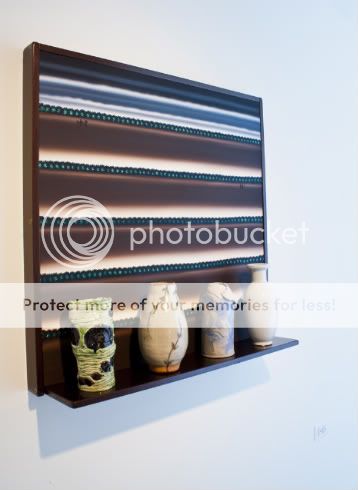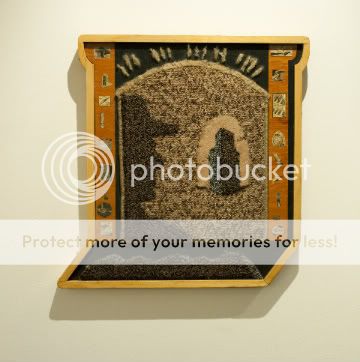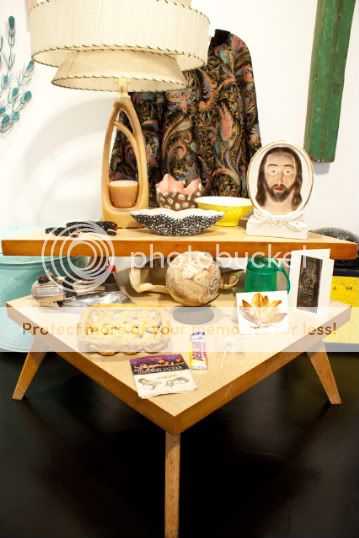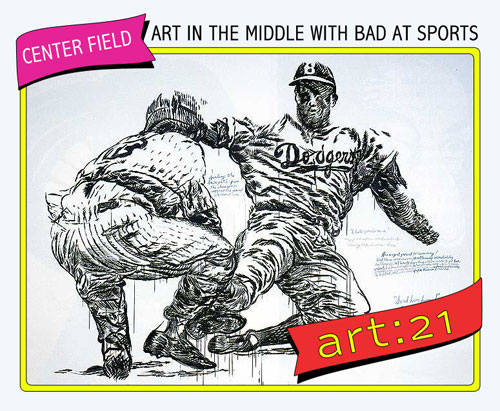After passing away in 1997, painter, sculptor, and notorious collector, Roger Brown bequeathed his homes and collections to his alma mater, the School of the Art Institute of Chicago (SAIC). His Chicago home located at 1926 N. Halsted became what is now the Roger Brown Study Collection (RBSC). Known as an “artist’s museum,” the study collection houses Brown’s work and collection intact. His New Buffalo home, which was designed by his partner, architect George Veronda, has become an artists’ retreat for SAIC staff and faculty.
Unlike his other residences, Brown’s home in La Conchita, California, was sold in 1998 and the contents were archived and moved to the RBSC. With the help of the study collection’s curator Lisa Stone, assistant curator James Connolly, and SAIC alum Dana Boutin, Chicago-based artist and curator Nicholas Lowe has organized an exhibition based on the work that Brown made and the objects he collected while living in California. Roger Brown: California U.S.A, currently on view at the Hyde Park Art Center, explores Brown’s Virtual Still Life paintings and the intricate relations that formed while working in his home in California.Meg Onli: How did this exhibition evolve and how did you decide to show Brown’s collection outside of his homes?
Nicholas Lowe: This exhibition grew from a discussion about what would be the best way to show [Brown’s] Virtual Still Life object series. There are 27 of these [paintings] and they were all made [from] 1995 to 1996, while Brown was living in La Conchita, CA, in the house that he commissioned Chicago architect Stanley Tigerman to build. Brown died in November 1997, and the house was subsequently sold in 1998. The contents, including all Brown’s personal possessions, from inside and outside the house were documented, cataloged, and packed. These items were placed in deep storage at the museum, and in 2008, with the help of Lisa Stone and her staff we began to unpack and assess the material.

Roger Brown, "Virtual Still Life #19 third Dynasty with a View," 1995, (cat. #14) Roger Brown: Calif. U.S.A. Hyde Park Art Center June - October 2010, Roger Brown Study Collection.
MO: As a Chicago Imagist, Brown had a history with the Hyde Park Art Center (HPAC). Was the HPAC an obvious choice when looking for a venue for the exhibition?
NL: There are many places that the exhibition would have looked good but it felt completely appropriate that we were able to exhibit this at Hyde Park. Brown had a long-standing association with Hyde Park. He and his colleagues, were instrumental in founding the art center and building its reputation. Brown had his first exhibition out of school at Hyde Park Art Center.
MO: I loved the small touches in the exhibition like the cacti in the windowsill. How much of the exhibition is installed based on Brown’s La Conchita home?
NL: All of the objects, except those on the shelves in front of the object paintings (these are integral to the paintings and fixed to the shelves by Brown when he made them) are reassembled and arranged in exactly the way that Brown had arranged them in La Conchita. They are organized based on photographs that we have of the house, taken [not only] by Brown and others who visited him, but also by the curatorial team who documented and packed the house. The cactus plantings are based on plantings as they were made by Brown in pots in his garden.

Roger Brown, "Cutting The Rug," Calif. U.S.A. Hyde Park Art Center June - October 2010, Roger Brown Study Collection.
MO: In an interview with Mark Price for Sculpture Magazine, Brown spoke of the three dimensional quality to his paintings. As a collector and sculptor did his Virtual Paintings (which are on display at the HPAC) become a natural progression for the work?
NL: The dimensional qualities in Brown’s work are present from the earliest time. In his school works like “Cutting The Rug” (pictured above) there are aspirations toward spatial quality and the introduction of materials and objects. The repurposing of objects is something that Brown established very early in his career under the influence of Joseph Cornell. Through studying single point perspective of early Renaissance paintings, and the collecting and appropriation of objects that he and his colleagues engaged in – Karl Wirsum, Ed Pascke, Don Baum and Christina Ramburg, [Brown began] placing objects in paintings and also painting objects.

Roger Brown, "Jesus Table (cat#20)," Calif. U.S.A. Hyde Park Art Center June - October 2010, Roger Brown Study Collection
MO: Did Brown’s collections change based on where he was living?
NL: Brown was influenced by the places in which he lived. The South West is very present in the La Conchita collection and in the artworks that Brown made while he was living there. Many of the items are Mexican. Mostly from about the 1920’s onwards but significantly representative of ceramic items from the 50’s and 60’s. The furniture is probably all from the 1980’s. There was a particular trend for faux-distressed cabinetry, tables, chairs and shelves from about the mid 1970’s onwards. We know from talking to Brown’s friends that he built his California collection over a period of about 5 years and purchased many of the ceramics in Santa Barbara.
MO: After working with this collection for so long do you see a lot of the connections between all of the objects or are you still discovering intricacies within them?
NL: My excitement [for] this exhibition is that the connections and cross currents are still unfolding. I visit the exhibition a couple times a week and the visual conversations that ensue continue to surprise me. For example, I was in the gallery with a small group of astronomers [who] were visiting. [As] we began to talk about one of the reassembled table arrangements called “Jesus Table” (pictured above) one of them [became] particularly interested, because there is a toy globe of Mars – he is a Mars specialist. I asked if he could see a reason why Mars might have been included in this arrangement as a reference. To begin with he said he didn’t think of it other than as an object, though it clearly dates to a period of rapid discovery in the late 50’s when telescope technology suddenly made topographic reproductions of the closer planets possible. The display contains two large, wall-mounted tin peacocks, Brown owned two live peacocks. I pointed out some of the peacock references in the arrangement ,and [the astronomer] remarked that there is a range of volcanos on Mars that have latin names associated with peacocks. Understanding these kinds of details has only become possible through the public display of the collection. We often have conversations with visitors at the Roger Brown Study Collection on Halsted Street that lead out in a similar way so it is a really great opportunity to have the La Concita materials finally accessible to study and scholarship. The depths are not yet plumbed by any means.





Pingback: Art in the Middle | Roger Brown: California U.S.A : Bad at Sports
Pingback: Roger Brown | observeandlook